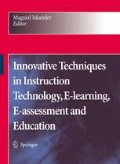Abstract
This paper presents: (1) the main issues and trends of portfolio development; (2) conceptual frameworks of using the weblog-based portfolio (blogfolio) as a means for enhancing performance-based teaching and learning; and (3) a case study which integrates the blogfolio into an online course for the purposes of building a sense of community and promoting student-centered collaboration, assessment, and reflection.
Access this chapter
Tax calculation will be finalised at checkout
Purchases are for personal use only
Preview
Unable to display preview. Download preview PDF.
References
P. M. Costantino and M. N. De Lorenzo, Developing a professional teaching portfolio: A guide for success. Boston, MA: Allyn & Bacon, 2002.
C. Danielson and L. Abrutyn, An Introduction to Using Portfolios in the Classroom. Alexandria: Association for Supervision and Curriculum Development, 1997.
K. Montgomery and D. Wiley, Creating e-portfolios using PowerPoint: A guide for educators. Thousand Oaks, CA: Corwin Press, 2004.
M. W. Olson, “Portfolios: Educational tools,” Reading Psychology: An International Quarterly, vol. 12 issue 1, pp. 73-80, 1991.
J. R. Aschermann. “Electronic portfolios: Why? what? how?” paper presented at the annual meeting of the Society for Information Technology and Teacher Education, San Antonio, TX, 1999.
L. Avraamidou and C. Zembal-Saul, “Exploring the influence of we-based portfolio development on learning to teach elementary science,” AACE Journal, vol. 14 issue 2, pp. 178-205, 2006.
R. H. Dollase, “The Vermont Experience in state-mandated portfolio approval,” Journal of Teacher Education, vol. 47 issue 2, pp. 85-98, 1996.
H. C. Barrett, “Electronic portfolio,” in Educational Technology: An Encyclopedia, 2001. <http://electronicportfolios.com/portfolios/encyclopediaentry.htm>
S. Watkins, “World Wide Web authoring in the portfolio-assessed, (inter)networked composition course,” Computers and Composition, vol. 13 issue 12, pp. 219-230, 1996.
N. Milman, “Web-based electronic teaching portfolios for preservice teachers,” paper presented at the annual meeting of the Society for Information Technology and Teacher Education, San Antonio, TX, March 1999.
J. Morris and H. Buckland, “Electronic portfolios for learning and assessment,” paper presented at the annual meeting of the Society for Information Technology and Teacher Education, San Diego, CA, March 2000.
M. E. Pierson and S. Kumari, “Web-based student portfolios in a graduate instructional technology program,” paper presented at the annual meeting of the Society for Information Technology and Teacher Education, San Diego, CA, March 2000.
B. Yates, J. Newsome, and T. Creighton, Standards based technology competencies: Electronic portfolios in preservice education,” paper presented at the annual meeting of the Society for Information Technology and Teacher Education, San Antonio, TX, March 1999.
J. I. Ayala, “Electronic portfolios for whom?” EDUCAUSE Quarterly, vol. 29 issue 1, pp. 12-13, 2006.
T. Martindale and D. A. Wiley, “Using weblogs in scholarship and teaching,” TechTrends, vol. 49 issue 2, pp. 55-61, 2005.
S. Downes, “Educational blogging,” EDUCAUSE Review, vol. 39 issue 5, pp. 14-26, 2004.
W. Richardson, Blogs, wikis, podcasts, and other powerful web tools for classroom. Thousand Oaks, CA: Corwin Press, 2006.
B. Ganley, “Blogging as a dynamic, transformative medium in an American liberal arts classroom,” 2004. <http://mt.middlebury.edu/middblogs/ganley/bgblogging/Blogging as a Dynamic.doc>
S. Fiedler, “Personal webpublishing as a reflective conversational tool for self-organized learning,” in t. Burg (Ed.), BlogTalks, T. Burg, Ed. Vienna, Austria, 2003, pp. 190-216.
F. Eide and B. Eide, “Brain of the blogger,” 2005. <http://eideneurolearningblog.blogspot.com/2005/03/brain-of-blogger.html>
UBCWiki, “Blogfolio/what,” 2005. <http://careo.elearning.ubc.ca/wiki?Blogfolio/What>
J. Tubbs, “Digital portfolios,” 2004. <http://futureofmath.misterteacher.com/digitalportfolios.html>
T. Anderson, L. Rourke, D. R. Garrison, and W. Archer, “Assessing teaching presence in a computer conferencing context,” Journal of Asynchronous Learning Networks, vol. 5 issue 2, pp. 1-17, 2001.
R. M. Palloff and K. Pratt, Building learning communities in cyberspace. San Francisco: Jossey-Bass Publishers, 1999.
A. P. Rovai, “A preliminary look at the structural differences of higher education classroom communities in traditional an ALN courses,” Journal of Asynchronous Learning Networks, vol. 6 issue 1, pp. 41-56, 2002.
D. H. Jonassen, Computers as mind tools for schools: Engaging critical thinking, 2nd ed., Upper Saddle River, NJ: Merrill, 2000.
L. Sherry, (1996). “Issues in distance learning,” International Journal of Educational Telecommunications, vol. 1 issue 4, pp. 337-365, 1996.
H. Yang, “Webliography,” in Encyclopedia of Information Technology Curriculum Integration. L. A. Tomei, Ed. Hershey, PA: Idea Group Publishing, in press.
B. Dodge, “Some thoughts about WebQuests,” 1997. <http://webquest.sdsu.edu/about_webquests.html>
A. P. Rovai, “Development of an instrument to measure classroom community,” Internet and Higher Education, vol. 5 issue 3, pp. 197-211, 2002.
S. Kajder and G. Bull, “A space for writing without writing,” Learning & Leading with Technology, vol. 31 issue 6, pp. 32-35, 2004.
Author information
Authors and Affiliations
Editor information
Editors and Affiliations
Rights and permissions
Copyright information
© 2008 Springer Science+Business Media B.V.
About this paper
Cite this paper
Yang, H.H. (2008). Blogfolios for Student-Centered Reflection and Communication. In: Iskander, M. (eds) Innovative Techniques in Instruction Technology, E-learning, E-assessment, and Education. Springer, Dordrecht. https://doi.org/10.1007/978-1-4020-8739-4_32
Download citation
DOI: https://doi.org/10.1007/978-1-4020-8739-4_32
Publisher Name: Springer, Dordrecht
Print ISBN: 978-1-4020-8738-7
Online ISBN: 978-1-4020-8739-4
eBook Packages: Computer ScienceComputer Science (R0)

